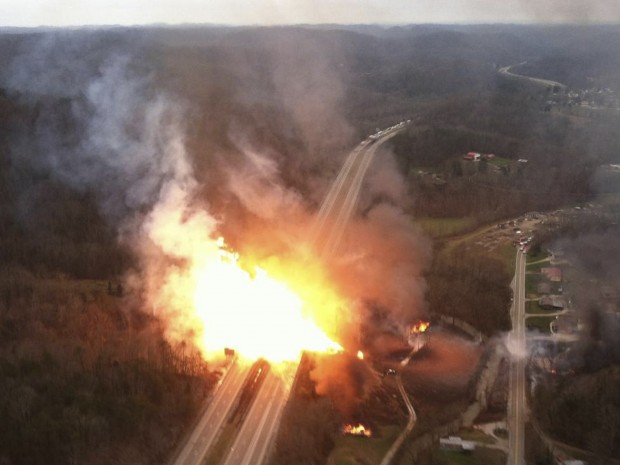U.S. proposes new safety rules for natural gas pipelines

AP Photo / West Virginia State Police
A fireball erupts across Interstate 77 from a gas pipeline explosion in Sissonville, W.Va. In the 2012 incident, the stretch of pipeline that ruptured hadnt been inspected or tested for 24 years.
Following a series of explosions and accidents the federal government announced Thursday it would expand safety rules for natural gas pipelines. Regulators cited a 2010 explosion in San Bruno, California that left eight people dead and injured more than 50.
“The significant growth in the nation’s production, usage and commercialization of natural gas is placing unprecedented demands on the nation’s pipeline system,” said U.S. Transportation Secretary Anthony Foxx said in a statement. “This proposal includes a number of commonsense measures that will better ensure the safety of communities living alongside pipeline infrastructure and protect our environment.”
The Associated Press first reported on the move, which would fall to the DOT’s Pipeline and Hazardous Materials Safety Administration (PHMSA). The rules would include pressure-testing on pipelines constructed before 1970, which has been a recommendation National Transportation Safety Board. Safety protocols that currently apply to densely populated areas would be expanded to include those with less population. PHMSA says the proposal would also help reduce the release of greenhouse gases from leaking pipes.
The proposed rules would also regulate, for the first time, rural gathering lines. Currently, all those thousands of miles of smaller pipe that get the gas from the wellhead to major transmission pipelines are not regulated in rural areas, which is where most of them are in Pennsylvania. There are no rules on how deep the lines should be underground, or even if they’re buried at all. And they doesn’t even have to be marked. No state or federal agency knows how many miles of lines there are, or where they are.
The presence of thousands of new miles of unregulated pipelines in Pennsylvania resulted in deadly consequences last July when a man operating a backhoe struck and hit an unmarked, high pressure gas line and then died of his injuries several months later. StateImpact reported on the incident last August in a piece about unmapped and unregulated rural pipelines. As as an example of how unregulated rural pipelines are, neither the federal Occupational Safety and Health Administration, nor the state Public Utility Commission, has the authority to issue any violations or fines to the company who owned and operated the unmarked line.
Lynda Farrell with the Pipeline Safety Coalition says she’s encouraged by PHMSA’s proposal to oversee rural gathering lines.
“It’s acutally a fairly decent proposal,” she said. “Particularly for us in Pennsylvania. [PHMSA] went further with the gathering lines than I thought they would go.”
The Department of Environmental Protection estimates about 10,000 new miles of gathering lines will be built in the state as a result of the Marcellus Shale boom.
But Farrell says the missing link to all safety regulations are staff to inspect the pipes and enforce the rules.
The Pipeline and Hazardous Materials Safety Administration says it employs a total of 509 people, and about 243 of these are Pipeline Inspection and Enforcement personnel, including inspectors, engineers, transportation specialists, lawyers, and other staff that support inspection and enforcement activities nationwide. Recently the agency was granted authorization to hire 109 new employees.
In a news release, PHMSA outlined other changes:
- Modifying repair criteria for pipelines inside and outside of high consequence areas
- Providing additional direction on how to evaluate internal inspection results to identify anomalies
- Clarifying requirements for conducting risk assessment for integrity management, including addressing seismic risk
- Expanding mandatory data collection and integration requirements for integrity management, including data validation and seismicity
- Requiring additional post-construction quality inspections to address coating integrity and cathodic protection issues
- Requiring new safety features for pipeline launchers and receivers, and requiring a systematic approach to verify a pipeline’s maximum allowable operating pressure (MAOP) and requiring operators to report MAOP exceedances
















